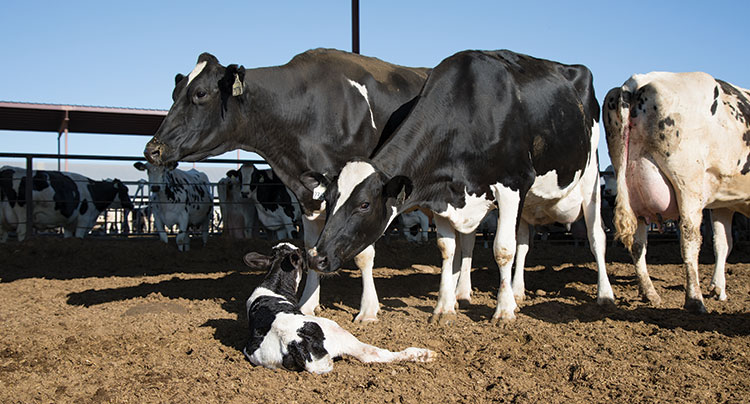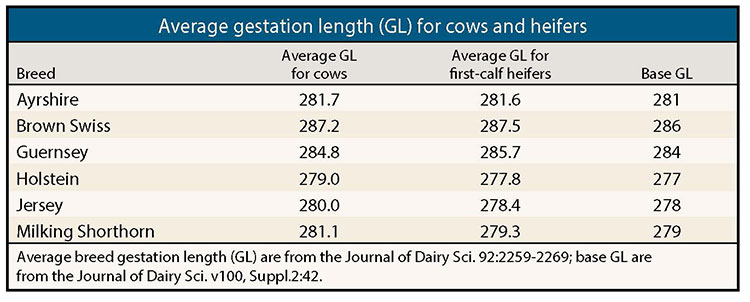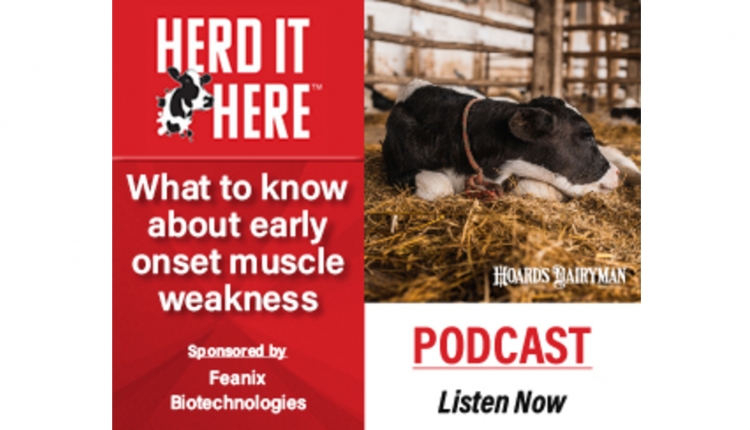
For instance, heifer calves are born a day or two earlier than bull calves on average, and twins four to five days earlier than single births. With the use of ultrasound, those sources of variation could be considered when projecting a due date.
Genetics matter, too
Thanks to efforts by scientists from USDA and CDCB (Council on Dairy Cattle Breeding), we can now predict due dates more accurately because we can better account for the genetic component of gestation length. Gestation length PTA (Predicted Transmitting Ability) was officially released by CDCB for the first time in August. Sires and cows that have been genotyped now have gestation length PTA available.
We’ve known for some time that there must be genetic differences in gestation length because there are significant differences among breeds. Average gestation lengths for our primary U.S. dairy breeds are reported in the accompanying table. I’ve reported average gestation length for cows and for first-calf heifers. I’ve also reported the average assumed by CDCB for the current genetic base of cows born in 2010.
As you can see, gestation length is shortest for Holstein and Jersey, and longest for Brown Swiss and Guernsey. Parturition also occurs a day or two earlier for first-calf Holstein, Jersey, and Milking Shorthorn heifers than for cows of the same breed.
Just as there are differences in gestation length among breeds, there are differences among sires within a breed. In fact, the heritability of service sire gestation length for first-calf heifers is 48 percent, which is higher than the heritability for nearly all traits currently included in our selection programs.
The standard deviation for gestation length PTA is 1.4 days. This means that we expect 95 percent of sires to be within 2.8 days of average. Current active Holstein sires range from -5 days to +4 days for gestation length PTA.
Using gestation length PTA
Bull studs may not have gestation length published on their animals yet because it is a new trait, but the data will become increasingly available to producers. There are many potential uses for this new data.
The most important use will be more accurate prediction of due dates. Producers will be able to reduce the frequency of cows accidentally calving in a close-up pen rather than in the maternity pen. On the other hand, producers can avoid cows taking up valuable space in the maternity pens that are not likely to calve for another few days. Dry-off dates can also be adjusted based on more accurate due dates.
In addition to more accurate due dates, producers could also select bulls specifically to alter gestation length. This is not uncommon in countries where seasonal calving is routinely practiced. Toward the end of the breeding window, producers use short gestation length sires to minimize their calving window. Likewise, one can use a longer gestation length bull early in the breeding season. Some bulls are marketed largely on the basis of their gestation length PTA in New Zealand, for instance. While seasonal calving is less common in the U.S., interest from seasonal calving herds was part of the motivation to provide gestation length evaluations.
Nonseasonal herds may also benefit from altering gestation length to some degree. A repeat breeder that is later in lactation could be bred to a shorter gestation length sire to help shave a few days off its calving interval.
While this may not be a large concern to most producers, more accurate prediction of due dates could help those trying to breed next year’s show calf. Knowing that a given sire has short gestation length could help to avoid the risk of a calf being born on the last day of November or February.
Smaller producers who use paper records and breeding calendars to monitor due dates can easily benefit from knowing a bull’s gestation length PTA. It is somewhat trickier for larger herds that rely on herd management software.
In some instances, software doesn’t readily accommodate differences between breeds much less different sires within a breed. I expect that the more advanced software programs will accommodate this capability in the future, but that does not mean gestation length PTA can’t be used by larger herds currently.
Probably the easiest use they can make of such data is to simply avoid sires that are outliers in either direction. Thus, they can rely on breed average gestation length and most cows will calve in the expected window.

An optimum gestation length?
It is clear that there are potential management applications to knowing a sire’s gestation length PTA, but is average gestation length a trait that we should consider changing over time? Probably not for most breeds. Most research suggests that gestation length is a trait with an intermediate optimum.
Too long of a gestation length raises the likelihood of calving difficulty. Similarly, gestation lengths slightly shorter than average are associated with somewhat improved calving difficulty scores. However, if we go too far toward short gestation length, we may see a rise in stillbirth rates. Gestation lengths lower than the current average are also associated with lower milk, fat, and protein yield than average to slightly above average gestation length in Holsteins. Overall, it appears that we would not benefit from selecting for a different gestation length.
It remains an unanswered question whether breeds with longer natural gestation lengths, such as Brown Swiss, would benefit from selection to reduce the length of pregnancy. Most research on optimal gestation length is based on Holsteins, and the results may be different for other breeds.
Despite an intermediate optimum, there is some evidence that there is a genetic trend toward shorter gestation length in Holsteins beginning in about 2000. Emphasis on calving ease could be part of the reason by causing a correlated decline in gestation length. For instance, O-man was a Holstein bull that had a large influence on the breed. O-man was known as a calving ease bull and was also an outlier for shorter than average gestation length.
The CDCB has been busy developing many new traits to improve our selection programs. For most of these traits, we want to improve the population to develop more efficient and healthier cows.
Gestation length is a different kind of trait. We may not want to change gestation length dramatically, but knowing when a cow will calve with greater confidence will help refine our management protocols.










